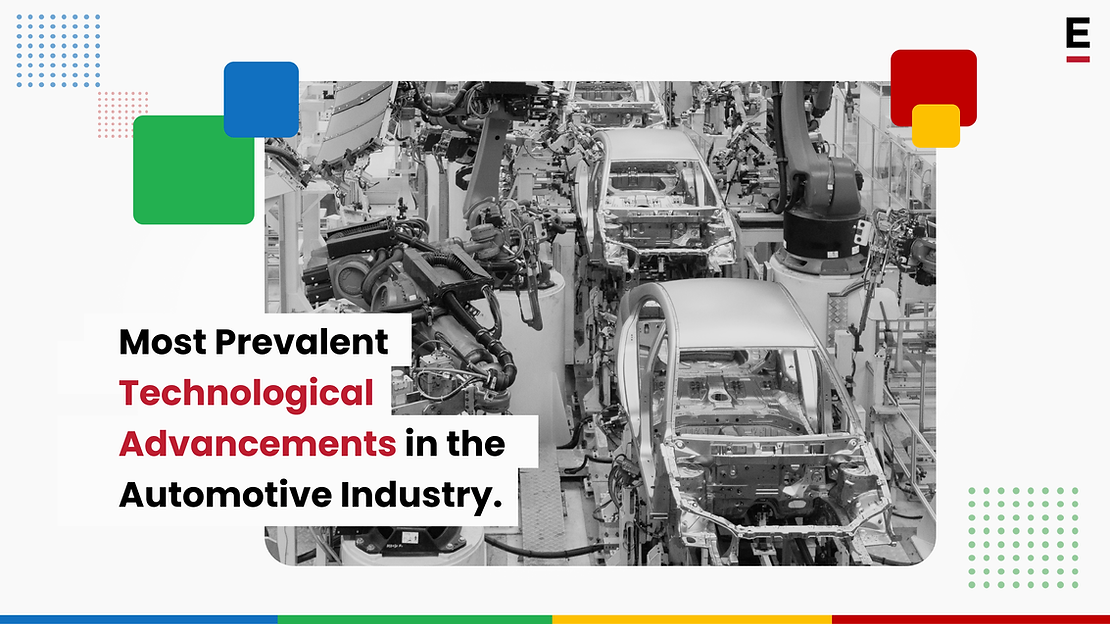The automotive industry has seen spectacular innovations in recent years. To make vehicles safer and more convenient, the automakers are riding on technologies a lot stronger and are exploring a million ways to make a difference to the driving experience. Owing to the concern for safety, significant progress is made towards making vehicles more pleasant and secure for the consumers.
Moreover, when it comes to today’s vehicles, electronic tech features are vital, and they are now an integral part of how one interacts with their car and how the vehicle interacts with the ones around it. These new-age tech features fall into the safety, security, communication, and connectivity features. In this blog, we will discuss some of the most recent automotive technology solutions in the automotive sector.
Advanced Driver Assistance System
ADAS is one of the latest Automotive Technology Solutions. When an ADAS-equipped vehicle detects an impending danger, it uses sensors like radar and cameras to gather information about its surroundings and either relays that information to the driver or takes appropriate action automatically. Advanced driver-assistance system (ADAS) is the technology used to make driving a car safer by automating, improving, or changing the tasks involved in operating a vehicle.
Some well-known examples are Toyota Safety Sense, Subaru EyeSight, Ford CoPilot360, Honda Sensing, and Nissan Safety Shield 360. Many automakers nowadays sell ADAS as a standalone option as well.
Vehicle Automatic Emergency Braking
This automotive tech solution protects you from rear-end collisions thanks to automated emergency braking. Cameras, radar, and other sensors detect impending danger and activate the automatic emergency brakes. These systems, such as the one from Bosch Mobility Solutions, will automatically apply the brakes if they see an object and determine a collision is imminent.
Some of the largest companies implementing AEB are Audi, Mercedes-Benz, Volvo, Tesla, BMW, Hyundai, Mazda, Subaru, Toyota, and Volkswagen. Ford, Honda, Nissan, Kia, and Porsche followed them. Soon, this technology would become a must-have in all light or heavy-duty vehicles, and many other manufacturers would adopt it.
Connected Mobile Apps or Digital Keys
With a mobile app, users of cars equipped with Digital Key technology can unlock and start their vehicles. The app recognizes an encryption key and may validate it once the phone is close to the car.
Hyundai Digital Key is an excellent example of this technology. Apart from iPhone users, most Android phones can use Hyundai Digital Key, and the digital key app includes everything you need to activate in the car, available at no cost.
Teen Driver Tech
Like a student’s report card, this auto tech solution keeps parents and kids apprised of their driving skills and development areas. Parents can use controls, such as speed and volume caps and warning signs to get their teens to drive more safely.
Parental controls in Teen Driver include
setting a maximum speed of 85 mph
receiving speed alerts, and
limiting the volume of the car radio
It automatically allows numerous well-known active safety components and prevents anyone from manually rotating them off, and it even mutes the radio when the front-seat inhabitants are not wearing safety belts.
Ford’s MyKey and General Motors’ Teen Driver are two examples of in-car technology suites, including speed limits that parents can set.
Safe Exit Assist
If you try to disable the Electronic Child Safety Lock, Safety Exit Assist will use radar to monitor your car and automatically lock the doors for you. An audio and visual warning will accompany this. Your child will not be able to open the back door until the car or the cycle behind them has passed, avoiding a fatal collision. When it is safe to do so, you can turn off the Electronic Child Safety Lock and let your child exit the vehicle. This innovation is a lifesaver for parents worldwide.
Hyundai was the first to introduce this system in their cars, and now Kia and Genesis have as well.
Wireless Technology
You can charge your phone wirelessly using induction coils installed in your car and on your phone. It means you can charge your phone without keeping a cable nearby. There is still much work done on the wireless battery management system, but all-electric vehicles use a wired system for now. The wiring harness between battery cells and battery sensor modules is complex in conventional BMS. The modern Battery Management System design eliminates the need for any connecting wiring between sensors and the actual BMS components. Shorter, more sensitive, more dependable, more comfortable, and most importantly, inexpensive battery packs are a goal of the WBMS.
Wireless technology for automobiles contains RF environments that use Wi-Fi with WAVE, Bluetooth, and GPS; the communication allows drivers to locate precisely and transmit information with low latency for efficient navigation. Modern communication networks such as LTE and LTE-Advanced enable smart cars to communicate with each other. The IoT (Internet of Things) and 5G network are pioneering effective management of smart driving.
Today’s wireless technologies are the next step ahead. We can connect our smartphones and other smart devices to automobiles using Wi-Fi, Bluetooth, and pair them with infotainment systems.
360-Degree Camera
One can obtain a real-time view of the area around your car through a 360-degree camera system. This represents the most innovative developments in the automotive sector recently. It combines the footage from multiple in-car cameras into a single overhead perspective. Using a 360-degree video system, you can see any obstacles in your path as you pull into a parking spot to avoid a collision. There are multiple angles that this camera covers, such as the front, rear, left, and right sides. This set-up helps the driver maneuver in tight spots, heavy traffic, and while parking.
Most automakers have implemented this technology widely, including global manufacturers such as Audi, Chevrolet, Mazda, Mercedes-Benz, Volkswagen, Volvo, Hyundai, Kia, Land Rover, Ford, Infiniti, Nissan, and Toyota.
Stolen Vehicle Tracking Software or Emergency Services
This program tracks the car’s movements and relays that information to authorities, who can then use it to retrieve it. You may monitor automobiles around the clock with this feature. It is more cost-effective than getting separate insurance for each vehicle.
When your automobile is stolen, this system can help you find it, slow it down, or even halt it in its tracks. OnStar is a popular technology that is standard on new General Motors vehicles and is open for buy for others. There are also incidences of customers locating their stolen vehicles using Apple AirTag or LoJack.
Blind-Spot View Monitor
When changing lanes, a blind-spot monitor’s clear screen will be helpful because it will display what is happening on each side of your vehicle. A small camera mounted on your car can show you what is happening in the lane beside you. This can lessen the likelihood of you colliding with another vehicle, motorbike, or cyclist.
This technology is seen in Volvo, Lincoln, Ford, Mercury, Mazda, and Mitsubishi. Soon many other automakers are expected to implement this technology widely.
Video Rear-view Mirror
The rear-view mirror promotes an alert driving experience. It allows you to see behind your vehicle without turning your head. It functions in the exact location as a conventional rear-view mirror, but it also allows you to choose between an analog image and a live video feed. You can monitor traffic and prepare for any potential dangers by checking the rear-view mirror. When towing, you can see more of the road and keep an eye on your vehicle simultaneously.
Some examples of video/digital rear-view mirrors are URVOLAX OEM 12″ Mirror Dash Cam, 4K Wi-Fi Mirror Dash Cam, Vehement 12″, WOLFBOX G850 4K Mirror Dash Cam, Volway 10″ 4K Mirror Dash Cam, etc.
These innovative developments in the automotive sector are just the beginning. Many innovations are underway, and automakers worldwide are focusing on their R&D to improve the driving experience. Soon many of these innovations will be a standard feature in automobiles, enhancing the security of its consumers.
Companies in the Automobile industry have spent a long time focusing on the mechanical side of automobile development and have left software to other parties. As in-car digital technology increasingly sets vehicles apart, the software will be the primary growth driver of manufacturers’ profit margins. The long-term goal of OEMs based on the recent automotive industry technology trends is to transform them into technology or software enterprises.
At Extentia, a Merkle company, we are well-versed with the automotive industry, its pain areas, and innovations. We support our clients from the industry and make a worldwide difference through their technological innovations and ideas. In the next blog, we will talk about the future technologies of the automotive industry; stay tuned!




